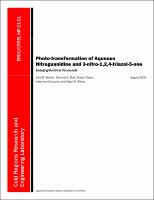Please use this identifier to cite or link to this item:
https://hdl.handle.net/11681/41743| Title: | Photo-transformation of aqueous nitroguanidine and 3-nitro-1,2,4-triazol-5-one : emerging munitions compounds |
| Authors: | Becher, Julie B. Beal, Samuel A. Taylor, Susan Dontsova, Katerina M. Wilcox, Dean E. |
| Keywords: | UV irradiation Nitroguanidine (NQ) 3-nitro-1; 2; 4-triazol-5-one (NTO) Transformation products Transformation pathways |
| Publisher: | Cold Regions Research and Engineering Laboratory (U.S.) Engineer Research and Development Center (U.S.) |
| Series/Report no.: | Miscellaneous Paper (Engineer Research and Development Center (U.S.)) ; no. ERDC/CRREL MP-21-21 |
| Is Version Of: | Becher, Julie B., Samuel A. Beal, Susan Taylor, Katerina Dontsova, and Dean E. Wilcox. "Photo-transformation of aqueous nitroguanidine and 3-nitro-1, 2, 4-triazol-5-one: Emerging munitions compounds." Chemosphere 228 (2019): 418-426. https://doi.org/10.1016/j.chemosphere.2019.04.131 |
| Abstract: | Two major components of insensitive munition formulations, nitroguanidine (NQ) and 3-nitro-1,2,4-triazol-5-one (NTO), are highly water soluble and therefore likely to photo-transform while in solution in the environment. The ecotoxicities of NQ and NTO solutions are known to increase with UV exposure, but a detailed accounting of aqueous degradation rates, products, and pathways under different exposure wavelengths is currently lacking. We irradiated aqueous solutions of NQ and NTO over a 32-h period at three ultraviolet wavelengths and analyzed their degradation rates and transformation products. NQ was completely degraded by 30 min at 254 nm and by 4 h at 300 nm, but it was only 10% degraded after 32 h at 350 nm. Mass recoveries of NQ and its transformation products were >80% for all three wavelengths. NTO degradation was greatest at 300 nm with 3% remaining after 32 h, followed by 254 nm (7% remaining) and 350 nm (20% remaining). Mass recoveries of NTO and its transformation products were high for the first 8 h but decreased to 22–48% by 32 h. Environmental half-lives of NQ and NTO in pure water were estimated as 4 and 6 days, respectively. We propose photo-degradation pathways for NQ and NTO supported by observed and quantified degradation products and changes in solution pH. |
| Description: | Miscellaneous Paper |
| Gov't Doc #: | ERDC/CRREL MP-21-21 |
| Rights: | Approved for Public Release; Distribution is Unlimited |
| URI: | https://hdl.handle.net/11681/41743 http://dx.doi.org/10.21079/11681/41743 |
| Appears in Collections: | Miscellaneous Paper |
Files in This Item:
| File | Description | Size | Format | |
|---|---|---|---|---|
| ERDC-CRREL MP-21-21.pdf | 761.9 kB | Adobe PDF |  View/Open |